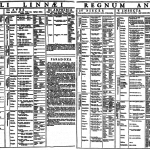 Welcome to the ICD Top 10 Countdown! ICD-10 is 2 days 15 hours and counting. Remember 15 years ago how everyone planned for Y2K, but 12:01 a.m. on January 1, 2000, came and we were all still here? Hopefully October 1 will dawn in a similar way and all of the contingency planning and practice submissions will have prepared us for a relatively painless transition.
Welcome to the ICD Top 10 Countdown! ICD-10 is 2 days 15 hours and counting. Remember 15 years ago how everyone planned for Y2K, but 12:01 a.m. on January 1, 2000, came and we were all still here? Hopefully October 1 will dawn in a similar way and all of the contingency planning and practice submissions will have prepared us for a relatively painless transition.
The blog topic this week, however, isn’t the ICD-10 countdown or Monday night football countdown or best-dressed Emmy red carpet countdown; it’s about language. ICD-10 is sort of related since it is a translation of clinical care into a discrete language for capturing the clinical work and, in the case of the U.S. health system, assigning value to the service for billing purposes. ICD-10 has nearly 70,000 different code sets to summarize patient diagnoses, and yet, it doesn’t fully embody all of the descriptive terms we might need to describe an individual patient encounter. The language of clinical medicine is rich with meaning when spoken among physicians and nurses, but it seems to lose power when translated into language that non-physicians need.
The downfall of business jargon in the medical world
Physicians have heard a lot of new language in the past decade: Accountable Care Organizations, bundled payments, patient-centered medical homes. The clash of patient care with business lingo is the subject of a recent article in The American Journal of Accountable Care by José Pagan and Brendan Saloner, “Do You Speak My Language? When Patient Care Meets Cost-Effectiveness.” The authors note that health systems responding to incentives and cost often use business language that does not resonate with clinical providers. Value-based payment models magnify the language disconnect between healthcare executives running the health system and providers delivering the care.
At worst, this disconnect can lead to animosity, so that one side stops listening to the other altogether. Even under more congenial circumstances the lack of shared language may result in clinical programs that do not deliver the desired results or with lukewarm clinician commitment, which makes a new program unsustainable.
Some Pagan and Saloner examples of business language that may not resonate with clinicians include health system objectives like “bending the cost curve,” reducing waste, and achieving milestones, targets, and deliverables. Clinician and patient language used to develop and plan a new project to meet these business objectives might include decreasing hospitalizations, mortality, and pain.
Translation, please
Successful health system projects express the objectives in shared-value terms using a common language. Often this requires one or more key individuals to create the shared dialogue, or to function as “translators.” Pagan and Saloner describe this work as, “creating a workable interpretation of a change that helps others to understand how it relates to their own values and vision.” In the health care organization that needs new and evolving clinical programs to achieve clinical and business goals, translators function to “speak the language of cost containment and organizational efficiency but also appreciate the training and values of clinical medicine.”
Patient-Centered Medical Home models are a good example of bringing business and clinical quality together with translated shared values. Recently the Patient-Centered Primary Care collaborative published, “Benefits of Implementing the Primary Care Patient-Centered Medical Home” which is a review of cost and quality results from public and private patient-centered medical home (PCMH) efforts. As this report outlines, colliding the business of medicine with meaningful clinical initiatives is desperately needed to trim the $2.5 trillion annual spend on health care in the U.S. PCMH successful efforts focus on health outcomes, patient and provider experience of care, expense reduction, and hospital and ER utilization. As a model of care, PCMH articulates and values clinical outcomes side by side with return on investment (ROI). The PCMH model, which supports multidisciplinary-team-based clinical care, has been embraced by primary care physicians and physician organizations.
I was recently in a meeting tilted to the business side of the healthcare see saw. The dialogue about a new business and clinical initiative was filled with value drivers, addressable spend, haircuts, PMPM, DRG collections, and, my personal favorite, episode groupers. Fortunately one of our healthcare organization translators was sitting next to me to whisper, “PMPM is per member per month.” He briefly explained episode grouper, too, but I had to look it up later to get the full story. Just FYI, episode groupers are software programs that bring together related healthcare beneficiaries claims to create an episode of care for a specific health problem. This enables a payer like Medicare to assign utilization and cost to a particular provider in a more meaningful way, such as understanding an individual provider’s performance in managing diabetes. Fortunately before this meeting was over we were able to talk about the clinical initiatives of care coordination for CKD and CVD, interventions for nutrition in CKD and medication reconciliation.
Creating shared values through a common language
If you are feeling frustrated and angry about the business jargon in your clinical practice it may be helpful to identify a translator. If your practice or health system business leaders seem one-sided in describing initiatives with only business terms, consider talking to them about the importance of creating shared clinical and business values by translating clinical and business goals into a common language. If you have the knowledge or interest, consider becoming a clinician translator for your practice or local health system.
Translators are special people who not only understand both languages, they can explain in a way that enables everyone to value the meaning. Katy Payne is a great example of a translator. She graduated from Cornell in the early 1960s with a music major and a biology minor, which seems like an odd combination. Katy’s husband was a whale biologist and as they studied whales together Katy realized that the whale sounds were not random, but had musical themes and melodic phrases. Because of her music major background she was uniquely able to hear the same sounds that other biologists heard, but to recognize them as translatable into music. She translated the whale songs into a language that we understand as humans. Today whales are recognized as composers of complex and evolving musical sounds. Humans are using signal processing and data mining techniques to catalog the complex musical compositions. Whale songs have helped to support human efforts to protect the species and their translation has changed forever the way humans interact with whales.
Clinician translators may have formal education in medicine and business or enough business interest and experience to speak the language and understand the concepts. They can help create a common language to align physicians with administrators in focusing on a patient-centered quality outcome.
How have you and your practice handled the language divide that seems to be growing between clinical medicine and healthcare executives? Join the conversation by posting a comment below.
 Dugan Maddux, MD, FACP, is the Vice President for CKD Initiatives for FMC-NA. Before her foray into the business side of medicine, Dr. Maddux spent 18 years practicing nephrology in Danville, Virginia. During this time, she and her husband, Dr. Frank Maddux, developed a nephrology-focused Electronic Health Record. She and Frank also developed Voice Expeditions, which features the Nephrology Oral History project, a collection of interviews of the early dialysis pioneers.
Dugan Maddux, MD, FACP, is the Vice President for CKD Initiatives for FMC-NA. Before her foray into the business side of medicine, Dr. Maddux spent 18 years practicing nephrology in Danville, Virginia. During this time, she and her husband, Dr. Frank Maddux, developed a nephrology-focused Electronic Health Record. She and Frank also developed Voice Expeditions, which features the Nephrology Oral History project, a collection of interviews of the early dialysis pioneers.




Leave a Reply